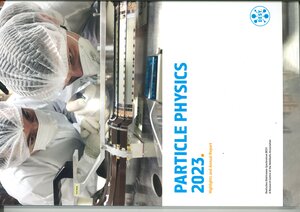
×
![Buchcover ISBN 9783945931509]()
Particle Physics 2023
Highlights and Annual Report
dard Model, this result has already sparked considerable
interest in the theory community. A new measurement of
the tau-lepton mass – performed by DESY scientists at
Belle II based on a method originally developed at the
ARGUS experiment at DESY’s former electron–positron
collider DORIS – is the most precise single determination
of this quantity ever achieved. On the LHC side, 15 years
into operation, ATLAS and CMS are still making important
observations. In particular, they are detecting ever rarer
processes! Events containing four top quarks were observed,
and, also for the first time, events with a W boson, a
Z boson and a high-energy photon, i. e. three different
bosons – in both cases with major DESY contributions!
In 2023, two events at DESY and in Hamburg offered
excellent opportunities for getting in closer touch with
other scientists: In August, the university campus was
occupied by the over 800 participants of the European
Physical Society Conference on High Energy Physics
(EPS-HEP2023), co-organised together with Universität
Hamburg. And in November, the 13th seminar of the
International Committee for Future Accelerators (ICFA)
took place at DESY, under the title “Future Perspectives in
High-Energy Physics”. Around 200 renowned scientists
assembled in the auditorium for a week of presentations
and intense discussions, surveying the entire field of
particle physics worldwide.
Conveying science, curiosity and the scientific method to
the general public, and particularly to children, is very
important for our future. One example that is especially
dear to me is the DESY school lab “physik. begreifen” (Fig. 2).
In existence for now more than 25 years, the classes have
attracted more than 7000 pupils per year – and we aim to
Particle physics
at DESY
Introduction
Dear Colleagues and Friends of DESY,
It’s the science that drives us, and the scientific and
technological challenges we need to master in order to
extract fascinating scientific results.
In the past year, 2023, two very demanding and exciting
projects were successfully brought to an – intermediate –
end: In March, the new pixel vertex detector for the Belle II
experiment at the KEK research centre in Japan was pre-
commissioned at DESY, in cooperation with numerous
German university colleagues, and shipped to KEK. After
its successful installation in the experiment in summer and
the subsequent commissioning and cosmic-ray data taking,
these early days of 2024 are seeing the first collision data
taking of the new component in the Belle II detector. And in
late May – thanks in particular to the perseverance of Axel
Lindner and his vision for axion experiments at DESY – we
could celebrate the start of data taking of the ALPS II
axion search experiment on our Hamburg campus (Fig. 1),
20 years after Andreas Ringwald first proposed the idea in
Physics Letters B (569, pp. 51–56, 2003). We are now
eagerly looking forward to first physics results from this
experiment, expected for summer 2024!
The upgrades for the Large Hardon Collider (LHC) at CERN
near Geneva and our contributions to the tracker endcaps
of the LHC experiments ATLAS and CMS – topics we have
been involved in for close to 10 years now! – are entering
the production phase: Almost all R& D has been carried
out, and the collaborations are about to start the actual
production. ATLAS has constructed its first petal from final
components and is preparing a full system test. CMS could
demonstrate, at DESY and with international partners, the
successful integration of modules into one half disk of the
mechanical substructure – the so-called “Dee”.
All these detector and technological enterprises are tech-
no logically fascinating, but we embark on them primarily in
order to achieve potentially revolutionary scientific results.
While not all individual results by experimentalists and
theorists at DESY are scientific game changers, they all
contribute to building up our knowledge and laying the
groundwork for a deeper understanding of our universe
and its history and future. Perseverance and patience are
just as important as innovation to ensure steady progress
while also enabling novel developments.
Let me mention four highlight results from 2023: Belle II
could establish first evidence for the rare decay of B mesons
into a kaon and two neutrinos, B → Kvv. With the measured
value being somewhat higher than predicted by the Stan-
increase this number to as many as 10 000 pupils per year
in the future! Another important format that addresses
young children is the federal foundation “Kinder Forschen”,
where we work as a network partner with kindergarden
educators to implement research in the daily kindergarden
routine. These are fantastic formats to foster curiosity and
help establish scientific thinking in society as one of the
pillars of our civilisation.
Unfortunately, we are also living in difficult times, with
many challenges and uncertainties that also affect DESY
and its employees. I am confident though that – thanks to
our outstanding competences, creativity and devotion – we
will be able to overcome them and adapt DESY so that we
emerge even stronger than before. We should embrace
our role as Germany’s premier lab for fundamental science
and trust that this role will continue to be appreciated
locally, nationally and internationally.
Let me close by thanking each and every one of you at
DESY and at our partner institutions around the world for
your sustained effort and commitment to excellent science
– it is much appreciated
interest in the theory community. A new measurement of
the tau-lepton mass – performed by DESY scientists at
Belle II based on a method originally developed at the
ARGUS experiment at DESY’s former electron–positron
collider DORIS – is the most precise single determination
of this quantity ever achieved. On the LHC side, 15 years
into operation, ATLAS and CMS are still making important
observations. In particular, they are detecting ever rarer
processes! Events containing four top quarks were observed,
and, also for the first time, events with a W boson, a
Z boson and a high-energy photon, i. e. three different
bosons – in both cases with major DESY contributions!
In 2023, two events at DESY and in Hamburg offered
excellent opportunities for getting in closer touch with
other scientists: In August, the university campus was
occupied by the over 800 participants of the European
Physical Society Conference on High Energy Physics
(EPS-HEP2023), co-organised together with Universität
Hamburg. And in November, the 13th seminar of the
International Committee for Future Accelerators (ICFA)
took place at DESY, under the title “Future Perspectives in
High-Energy Physics”. Around 200 renowned scientists
assembled in the auditorium for a week of presentations
and intense discussions, surveying the entire field of
particle physics worldwide.
Conveying science, curiosity and the scientific method to
the general public, and particularly to children, is very
important for our future. One example that is especially
dear to me is the DESY school lab “physik. begreifen” (Fig. 2).
In existence for now more than 25 years, the classes have
attracted more than 7000 pupils per year – and we aim to
Particle physics
at DESY
Introduction
Dear Colleagues and Friends of DESY,
It’s the science that drives us, and the scientific and
technological challenges we need to master in order to
extract fascinating scientific results.
In the past year, 2023, two very demanding and exciting
projects were successfully brought to an – intermediate –
end: In March, the new pixel vertex detector for the Belle II
experiment at the KEK research centre in Japan was pre-
commissioned at DESY, in cooperation with numerous
German university colleagues, and shipped to KEK. After
its successful installation in the experiment in summer and
the subsequent commissioning and cosmic-ray data taking,
these early days of 2024 are seeing the first collision data
taking of the new component in the Belle II detector. And in
late May – thanks in particular to the perseverance of Axel
Lindner and his vision for axion experiments at DESY – we
could celebrate the start of data taking of the ALPS II
axion search experiment on our Hamburg campus (Fig. 1),
20 years after Andreas Ringwald first proposed the idea in
Physics Letters B (569, pp. 51–56, 2003). We are now
eagerly looking forward to first physics results from this
experiment, expected for summer 2024!
The upgrades for the Large Hardon Collider (LHC) at CERN
near Geneva and our contributions to the tracker endcaps
of the LHC experiments ATLAS and CMS – topics we have
been involved in for close to 10 years now! – are entering
the production phase: Almost all R& D has been carried
out, and the collaborations are about to start the actual
production. ATLAS has constructed its first petal from final
components and is preparing a full system test. CMS could
demonstrate, at DESY and with international partners, the
successful integration of modules into one half disk of the
mechanical substructure – the so-called “Dee”.
All these detector and technological enterprises are tech-
no logically fascinating, but we embark on them primarily in
order to achieve potentially revolutionary scientific results.
While not all individual results by experimentalists and
theorists at DESY are scientific game changers, they all
contribute to building up our knowledge and laying the
groundwork for a deeper understanding of our universe
and its history and future. Perseverance and patience are
just as important as innovation to ensure steady progress
while also enabling novel developments.
Let me mention four highlight results from 2023: Belle II
could establish first evidence for the rare decay of B mesons
into a kaon and two neutrinos, B → Kvv. With the measured
value being somewhat higher than predicted by the Stan-
increase this number to as many as 10 000 pupils per year
in the future! Another important format that addresses
young children is the federal foundation “Kinder Forschen”,
where we work as a network partner with kindergarden
educators to implement research in the daily kindergarden
routine. These are fantastic formats to foster curiosity and
help establish scientific thinking in society as one of the
pillars of our civilisation.
Unfortunately, we are also living in difficult times, with
many challenges and uncertainties that also affect DESY
and its employees. I am confident though that – thanks to
our outstanding competences, creativity and devotion – we
will be able to overcome them and adapt DESY so that we
emerge even stronger than before. We should embrace
our role as Germany’s premier lab for fundamental science
and trust that this role will continue to be appreciated
locally, nationally and internationally.
Let me close by thanking each and every one of you at
DESY and at our partner institutions around the world for
your sustained effort and commitment to excellent science
– it is much appreciated


